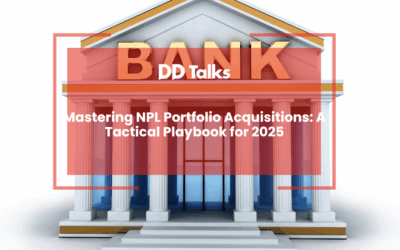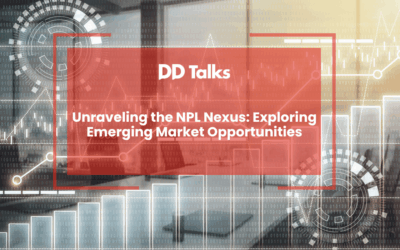Key Takeaways: NPL Securitization Insights
- NPL securitization transforms distressed bank assets into tradeable securities, providing capital relief for banks and investment opportunities for investors.
- Investment returns in NPL markets range from high single digits to potential double-digit yields, depending on tranche risk and asset quality.
- Strategic investment requires deep understanding of jurisdictional differences, particularly in European markets with varying regulatory frameworks.
- Technological innovations like AI and blockchain are increasingly shaping NPL investment strategies, promising enhanced operational efficiency.
- Robust risk management frameworks are critical, incorporating comprehensive due diligence, adaptive recovery strategies, and continuous market monitoring.
- Future NPL investment trends point towards greater market standardization, digital platforms, and specialized investment vehicles.
Table of Contents
- Understanding NPL Securitization: Core Mechanisms and Benefits
- How Does NPL Securitization Transform Distressed Assets?
- Investment Returns and Risk Analysis in NPL Markets
- Strategic Jurisdictions for NPL Investment Opportunities
- Global Investment Trends in Distressed Asset Markets
- Risk Management Frameworks for NPL Securities
- Future Outlook: Innovation in NPL Investment Strategies
Understanding NPL Securitization: Core Mechanisms and Benefits
The NPL securitization process has emerged as a crucial mechanism for European banks to manage their distressed asset portfolios effectively. This financial engineering technique involves transforming illiquid non-performing loans into tradeable securities, creating new opportunities for both banks and investors. The process typically involves multiple stakeholders, including originating banks, special servicers, rating agencies, and institutional investors.
Banks benefit from immediate capital relief and improved balance sheet metrics, while investors gain access to potentially high-yielding assets with diverse risk profiles. The market has evolved significantly since the 2008 financial crisis, with sophisticated structures and enhanced transparency measures becoming standard practice. Recent developments in the CEE region have demonstrated the growing maturity of this market segment.
How Does NPL Securitization Transform Distressed Assets?
The transformation of distressed assets through securitization follows a structured approach, beginning with careful asset selection and pool formation. Banks typically group NPLs with similar characteristics, such as asset type, vintage, or geographic location, to create coherent portfolios. This pooling strategy enhances the predictability of cash flows and simplifies risk assessment for potential investors.
The tranching process creates different security classes, each with distinct risk-return profiles. Senior tranches offer lower risk and returns, while junior tranches carry higher risk but potentially greater rewards. Rating agencies play a crucial role in evaluating these structures, considering factors such as historical recovery rates, servicing quality, and legal framework efficiency.
Investment Returns and Risk Analysis in NPL Markets
Investment returns in NPL securities vary significantly based on tranche position, underlying asset quality, and market conditions. Expected yields typically range from high single digits for senior tranches to potential double-digit returns for junior positions. Success in this market requires sophisticated risk assessment frameworks that consider both macro-economic factors and asset-specific characteristics.
Performance metrics focus on recovery rates, time to resolution, and cost efficiency of collection processes. Market volatility factors include regulatory changes, economic cycles, and servicing capability variations across jurisdictions. Investors must maintain robust monitoring systems to track these parameters effectively.
Strategic Jurisdictions for NPL Investment Opportunities
European markets present varying opportunities for NPL investment, with Southern European countries historically offering larger volumes of distressed assets. Each jurisdiction maintains distinct regulatory frameworks that significantly impact investment strategies. Understanding these differences is crucial for successful cross-border investments.
Growth markets analysis reveals emerging opportunities in Central and Eastern Europe, where improving legal frameworks and economic growth create favourable conditions for NPL resolution. Investors must consider factors such as court efficiency, enforcement procedures, and local servicing capabilities when selecting target markets.
Global Investment Trends in Distressed Asset Markets
Current market dynamics show increasing sophistication in NPL investment strategies, with specialized funds and traditional investors adapting their approaches to changing market conditions. Investor profiles range from large international funds to specialized boutique firms, each bringing unique expertise and investment objectives to the market.
Emerging opportunities include technology-enabled servicing platforms and innovative financing structures. The market cycle positioning suggests continued growth in certain regions, while others show signs of maturation, creating a diverse landscape for strategic investment decisions.
Risk Management Frameworks for NPL Securities
Effective risk management in NPL investments requires comprehensive due diligence processes covering legal, operational, and financial aspects. Monitoring systems must track both portfolio performance and broader market indicators. Compliance requirements vary by jurisdiction but typically include regular reporting, investor protection measures, and transparency obligations.
Recovery strategies need to be adaptable, considering both traditional collection methods and alternative resolution approaches. Successful frameworks incorporate stress testing scenarios and contingency planning for various market conditions.
Future Outlook: Innovation in NPL Investment Strategies
The future of NPL investment strategies is increasingly shaped by technological innovation, with artificial intelligence and blockchain solutions enhancing operational efficiency. Market evolution predictions suggest greater standardisation of processes and improved transparency through digital platforms.
New investment vehicles are emerging, including specialized REITs and digital asset platforms. Regulatory changes ahead focus on strengthening investor protection while maintaining market efficiency. These developments promise to reshape the NPL investment landscape, creating new opportunities for sophisticated investors.
Frequently Asked Questions
- What is NPL Securitization?
- NPL (Non-Performing Loan) Securitization is a financial process where banks transform illiquid distressed loans into tradeable securities, enabling banks to remove bad debt from their balance sheets while providing investors with potentially high-yield investment opportunities.
- How Do Investors Benefit from NPL Securities?
- Investors can gain access to diversified asset portfolios with potentially high returns, ranging from 7-15% depending on the tranche risk profile. Benefits include portfolio diversification, potential for higher yields compared to traditional fixed-income investments, and exposure to unique market segments.
- Which European Regions Offer the Best NPL Investment Opportunities?
- Southern European countries like Italy, Greece, and Spain traditionally offer large NPL volumes, while Central and Eastern European markets are emerging as attractive investment destinations due to improving legal frameworks and economic growth conditions.
- What Risks Are Associated with NPL Investments?
- Key risks include economic volatility, regulatory changes, recovery rate uncertainties, and variations in legal enforcement across jurisdictions. Successful investors mitigate these risks through comprehensive due diligence, diversification, and sophisticated risk management frameworks.
- How Has Technology Impacted NPL Investment Strategies?
- Technological innovations like artificial intelligence and blockchain are transforming NPL investments by enhancing operational efficiency, improving transparency, creating digital asset platforms, and enabling more sophisticated risk assessment and monitoring techniques.
- What Determines the Value of NPL Securities?
- NPL security values are determined by factors including underlying asset quality, historical recovery rates, geographic location, legal framework efficiency, servicing capabilities, and broader economic conditions in the target market.
- Are NPL Investments Suitable for All Investors?
- NPL investments are typically recommended for sophisticated institutional investors and high-net-worth individuals who understand complex financial instruments, can tolerate higher risk, and have the resources for comprehensive due diligence and portfolio management.
Impact of NPL Portfolio on the Economy




0 Comments